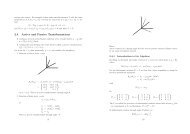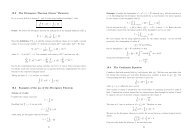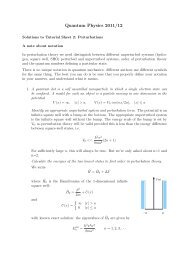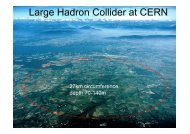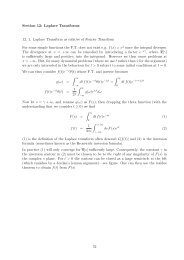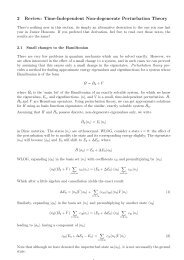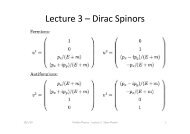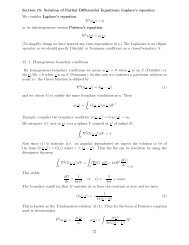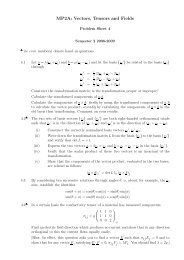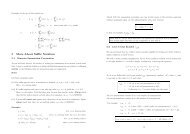Lecture 4 â Quantum Electrodynamics (QED)
Lecture 4 â Quantum Electrodynamics (QED)
Lecture 4 â Quantum Electrodynamics (QED)
- No tags were found...
Create successful ePaper yourself
Turn your PDF publications into a flip-book with our unique Google optimized e-Paper software.
<strong>Lecture</strong> 4 – <strong>Quantum</strong> <strong>Electrodynamics</strong> (<strong>QED</strong>) An introduc9on to the quantum field theory of the electromagne9c interac9on 22/1/10 Par9cle Physics <strong>Lecture</strong> 4 Steve Playfer 1
The Feynman Rules for <strong>QED</strong> Incoming (outgoing) fermions have spinors u (u) (where u = u*γ 0 ) Incoming (outgoing) an9fermions have spinors v (v) Incoming (outgoing) photons have polariza9on vectors ε µ (ε µ ) Ver9ces have dimensionless coupling constants √αAt low four-‐momentum transfers (q 2 ), α = e 2 /c = 1/137 Virtual photons have propagators 1/q 2 Virtual fermions have propagators (γ µ q µ + m)/(q 2 – m 2 ) 15/1/10 Par9cle Physics <strong>Lecture</strong> 2 Steve Playfer 2
Summing Diagrams The Matrix Element for a transi9on is the sum of all possible Feynman diagrams connec9ng the ini9al and final states A minus sign is needed to asymmetrise between diagrams that differ by the interchange of two iden9cal fermions For <strong>QED</strong> the sum of higher order diagrams converges. There are more diagrams with higher numbers of ver9ces … but for every two ver9ces you have a factor of α=1/137 The most precise <strong>QED</strong> calcula9ons go up to O(α 5 ) diagrams 22/1/10 Par9cle Physics <strong>Lecture</strong> 4 Steve Playfer 3
El objetivo primario del estudio fue la supervivencia libre de progresión (SLP),- analizadaademás de por los investigadores, por un Comité de Revisión independiente-. Los objetivossecundarios fueron la supervivencia global (SG), la SLP de acuerdo al criterio del investigador,el perfil de seguridad, la tasa de respuesta global y la duración de la misma, el intervalo detiempo hasta la progresión de síntomas y la correlación de biomarcadores con resultadosclínicos.Los efectos adversos más frecuentes (por encima del 30%) asociados al uso de Pertuzumab,Herceptin® y quimioterapia fueron diarrea, caída del cabello, número reducido de leucocitoscon o sin fiebre, molestias intestinales, fatiga, erupción cutánea y neuropatía periférica(entumecimiento, hormigueo). Las reacciones más comunes de grado 3-4 (inferiores al 2%)fueron número reducido de leucocitos con o sin fiebre, descenso de las cifras de ciertos tiposde leucocitos, diarrea, lesiones nerviosas, bajada de la cifra de glóbulos rojos, debilidad yfatiga 2 .Acerca de PertuzumabPertuzumab es el primero de una nueva generación de agentes dirigidos denominadosInhibidores de la Dimerización del HER2 (HDI por sus siglas en inglés). Previene que elreceptor HER2 dimerice (se una) al receptor HER3 Se cree que, de este modo, Pertuzumabbloquea la transmisión celular de señales, pudiendo así inhibir el crecimiento de las célulascancerosas o conducir a su muerte. La unión del Pertuzumab a HER2 también podría inducir alsistema inmunitario a destruir las células cancerosas. Los mecanismos de acción dePertuzumab y de Herceptin parece que se complementan, permitiendo un bloqueo máscompleto de las vías de señalización del HER.La indicación aprobada en Estados Unidos para Perjeta® es en combinación con Herceptin®(Trastuzumab) y docetaxel en mujeres con cáncer de mama HER2 positivo metastásico que nohan recibido tratamiento anti-HER2 ni quimioterapia previa para el tratamiento de suenfermedad metastásica. La decisión de las autoridades europeas se espera para mediados defebrero.Acerca del cáncer de mamaEl cáncer de mama es la neoplasia maligna más frecuente en las mujeres en todo el mundo 3 .Cada año se diagnostican 1,4 millones de nuevos casos, con una tasa anual de mortalidadcercana a los 450.000 fallecimientos por esta enfermedad. El cáncer de mama HER2 positivose caracteriza por la presencia de cantidades elevadas de la proteína HER2 (receptor 2 delfactor de crecimiento epidérmico humano) en la superficie de las células tumorales, lo que sedenomina “positividad de HER2” y afecta al 15-25% de las mujeres con cáncer de mama 4 .Estesubtipo se caracteriza porque evoluciona de forma especialmente agresiva 5 .Referencias1. Swain S, et al. Confirmatory overall survival analysis of CLEOPATRA: A randomized, double-blind, placebocontrolledPhase III study with pertuzumab, trastuzumab, and docetaxel in patients with HER2-positive firstlinemetastatic breast cancer. Poster presentation at the 2012 CTRC-AACR San Antonio Breast Cancer
High Energy e-‐µ sca[ering In the limit E>>m it can be shown that fermion helicity is conserved during the sca[ering process: u γ µ u = u L γ µ u L + u R γ µ u R There are only four possible spin configura9ons: The unpolarized matrix element squared is: |M| 2 = 1 α 2 Σ S3 ,S 4 (u 3 γ µ u 1 ) * (u 3 γ µ u 1 ) (u 4 γ µ u 2 ) * (u 4 γ µ u 2 ) (2S 1 +1)(2S 2 +1) q 4 |M| 2 = 2e 4 (s 2 + u 2 ) = 2e 4 (1 + 4cos 4 θ/2) t 2 sin 4 θ/2 22/1/10 Par9cle Physics <strong>Lecture</strong> 4 Steve Playfer 5
Cross-‐sec9on for e + e → µ + µ e + Related to e-‐µ sca[ering by crossing symmetry t s (90 o rota9on of Feynman diagram) e µ µ + |M| 2 = 2e 4 (t 2 + u 2 ) = e 4 (1+cos 2 θ) s 2 Separated into allowed spin configura9ons: Differen9al cross-‐sec9on: dσ = e 4 ( 1 + cos 2 θ) dΩ 4s Total cross-‐sec9on: σ = 4πα 2 (decreases with increasing CM energy) 3s 22/1/10 Par9cle Physics <strong>Lecture</strong> 4 Steve Playfer 6
22/1/10 Par9cle Physics <strong>Lecture</strong> 4 Steve Playfer 7
Halzen & Mar9n P.129 22/1/10 Par9cle Physics <strong>Lecture</strong> 4 Steve Playfer 8
Higher Order <strong>QED</strong> Diagrams -‐ I Two photon exchange diagrams (“box” diagrams) These add two ver9ces with a factor of α = 1/137 p 1 p 1 + k p 3 p 1 k p 3 k k q k p 1 k k p 3 k p 2 p 2 k t channel p 4 p 2 q k s channel p 4 The four momentum k flowing round the loop can be anything! Need to integrate over ∫ f(k) d 4 k Unfortunately this integral gives ln(k) which diverges! This is solved by “renormalisa9on” in which the infini9es are “miraculously swept up into redefini9ons of mass and charge” (Aitchison & Hey P.51) 22/1/10 Par9cle Physics <strong>Lecture</strong> 4 Steve Playfer 9
Higher Order <strong>QED</strong> Diagrams -‐ II A virtual photon can be emi[ed and reabsorbed across a vertex. This effec9vely changes the coupling at the vertex. A real (or virtual) fermion can emit and reabsorb a virtual photon. This modifies the fermion wavefunc9on. When the photon is emi[ed the fermion becomes virtual and changes its 4-‐momentum. In a virtual photon propagator a fermion-‐an9fermion pair can be produced and then annihilate. This modifies the photon propagator. Any charged fermion is allowed (quarks and leptons)! Each of these diagram adds two ver9ces with a factor of α = 1/137 Again four momentum flowing round a loop can be anything! 22/1/10 Par9cle Physics <strong>Lecture</strong> 4 Steve Playfer 10
Gyromagne9c Ra9o g Measures the ra9o of the magne9c moment to the spin µ = g µ B S for an electron with the Bohr magneton µ B = em e c = 5.8x10 -‐11 MeV/T From the Dirac equa9on expect g=2 for a pointlike fermion Higher order diagrams lead to an anomalous magne9c moment described by g2 The <strong>QED</strong> contribu9ons have been calculated to O(α 5 ) The theore9cal calcula9on is now limited by strong interac9ons (correc9ons from the bubble diagrams with quarks) 22/1/10 Par9cle Physics <strong>Lecture</strong> 4 Steve Playfer 11
Accuracy of g-‐2 Measurements • Anomalous magne9c moment of electron • Anomalous magne9c moment of muon Some argument about a 2-‐3σ discrepancy in the muon g-‐2 at the moment! 22/1/10 Par9cle Physics <strong>Lecture</strong> 4 Steve Playfer 12
Renormalisa9on • Impose a “cutoff” mass M on the four momentum inside a loop – This can be interpreted as a limit on the shortest range of the interac9on – It can also be interpreted as possible substructure in pointlike fermions – Physical amplitudes should not depend on choice of M • Assume M 2 >> q 2 (but not infinity!) • ln(M 2 ) terms appear in the amplitude – These terms are absorbed into fermion masses and vertex couplings • The masses m(q 2 ) and couplings α(q 2 ) are func9ons of q 2 • Renormalisa9on of electric charge: e R = e (1 – e 2 ln (M 2 /m 2 ) ) 1/2 12π 2 N.B. This formula assumes only one type of fermion/an9fermion loop Can be interpreted as a “screening” correc9on due to the produc9on of electron/positron pairs in a region round the primary vertex 22/1/10 Par9cle Physics <strong>Lecture</strong> 4 Steve Playfer 13
Running Coupling Constant Conver9ng from electric charge to fine structure constant and allowing for all fermion types: α(q 2 ) = α(0) (1 + α(0) z f ln (q 2 /M 2 ) ) where z f = Σ f Q f2 is a sum over the ac9ve fermion/an9fermion charges (in units of e) 3π z f is a func9on of q 2 : = 1 (1MeV), = 8/3 (1 GeV), = 38/9 (100GeV) A trick is to replace the M 2 dependence with a reference value µ: α(q 2 ) = α(µ 2 ) (1 α(µ 2 ) z f ln (q 2 /µ 2 ) ) -‐1 3π Can choose any value of µ. For <strong>QED</strong> usual choice is µ~1 MeV, α=1/137 (from atomic physics) An alterna9ve is µ=M Z , α(M Z )=1/129 22/1/10 Par9cle Physics <strong>Lecture</strong> 4 Steve Playfer 14



